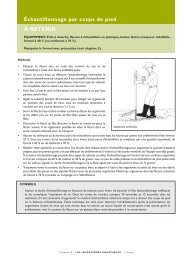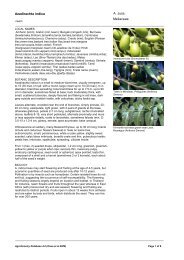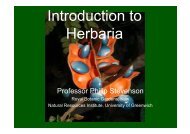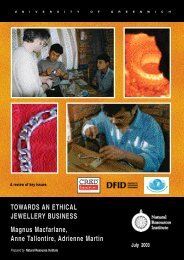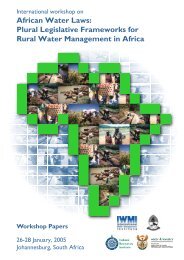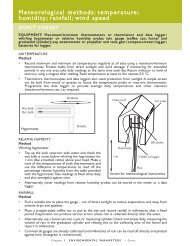botanical insecticides, deterrents, and repellents in modern ...
botanical insecticides, deterrents, and repellents in modern ...
botanical insecticides, deterrents, and repellents in modern ...
Create successful ePaper yourself
Turn your PDF publications into a flip-book with our unique Google optimized e-Paper software.
Annu. Rev. Entomol. 2006.51:45-66. Downloaded from arjournals.annualreviews.org<br />
by University of British Columbia Library on 12/09/05. For personal use only.<br />
52 ISMAN<br />
has spurred the development of essential oil-based <strong><strong>in</strong>secticides</strong>, fungicides, <strong>and</strong><br />
herbicides for agricultural <strong>and</strong> <strong>in</strong>dustrial applications <strong>and</strong> for the consumer market,<br />
us<strong>in</strong>g rosemary oil, clove oil, <strong>and</strong> thyme oil as active <strong>in</strong>gredients. Interest <strong>in</strong> these<br />
products has been considerable, particularly for control of greenhouse pests <strong>and</strong><br />
diseases <strong>and</strong> for control of domestic <strong>and</strong> veter<strong>in</strong>ary pests, with several private<br />
companies (e.g., EcoSMART Technologies, Inc., United States) mov<strong>in</strong>g toward or<br />
<strong>in</strong>to the marketplace. Another factor favor<strong>in</strong>g development of <strong>botanical</strong> <strong><strong>in</strong>secticides</strong><br />
based on plant essential oils is the relatively low cost of the active <strong>in</strong>gredients, a<br />
result of their extensive worldwide use as fragrances <strong>and</strong> flavor<strong>in</strong>gs. In contrast,<br />
pyrethrum <strong>and</strong> neem are used primarily for <strong>in</strong>secticide production (R. Georgis,<br />
personal communication).<br />
Rotenone <strong>and</strong> Other Extant Botanicals<br />
As an <strong>in</strong>secticide, rotenone has been <strong>in</strong> use for more than 150 years, but its use as a<br />
fish poison dates back even further (82). Rotenone is one of several isoflavonoids<br />
produced <strong>in</strong> the roots or rhizomes of the tropical legumes Derris, Lonchocarpus,<br />
<strong>and</strong> Tephrosia. Most rotenone used at present comes from Lonchocarpus grown <strong>in</strong><br />
Venezuela <strong>and</strong> Peru <strong>and</strong> is often called cubé root. Extraction of the root with organic<br />
solvents yields res<strong>in</strong>s conta<strong>in</strong><strong>in</strong>g as much as 45% total rotenoids; studies <strong>in</strong>dicate<br />
that the major constituents are rotenone (44%) (Figure 1) <strong>and</strong> deguel<strong>in</strong> (22%) (15,<br />
30). Rotenone is commonly sold as a dust conta<strong>in</strong><strong>in</strong>g 1% to 5% active <strong>in</strong>gredients<br />
for home <strong>and</strong> garden use, but liquid formulations used <strong>in</strong> organic agriculture can<br />
conta<strong>in</strong> as much as 8% rotenone <strong>and</strong> 15% total rotenoids.<br />
Rotenone is a mitochondrial poison, which blocks the electron transport cha<strong>in</strong><br />
<strong>and</strong> prevents energy production (41). As an <strong>in</strong>secticide it is considered a stomach<br />
poison because it must be <strong>in</strong>gested to be effective. Pure rotenone is comparable<br />
to DDT <strong>and</strong> other synthetic <strong><strong>in</strong>secticides</strong> <strong>in</strong> terms of its acute toxicity to mammals<br />
(rat oral LD50 is 132 mg kg −1 ), although it is much less toxic at the levels seen<br />
<strong>in</strong> formulated products. Safety of rotenone has recently been called <strong>in</strong>to question<br />
because of (a) controversial reports that acute exposure <strong>in</strong> rats produces bra<strong>in</strong><br />
lesions consistent with those observed <strong>in</strong> humans <strong>and</strong> animals with Park<strong>in</strong>son’s<br />
disease (10), <strong>and</strong> (b) the persistence of rotenone on food crops after treatment. A<br />
study of rotenone residues on olives conducted <strong>in</strong> Italy determ<strong>in</strong>ed that the halflife<br />
of rotenone is 4 days, <strong>and</strong> at harvest residue levels were above the tolerance<br />
limit (17). Moreover, residues were concentrated <strong>in</strong> oil obta<strong>in</strong>ed from the olives.<br />
As an agricultural <strong>in</strong>secticide, use of rotenone is limited to organic food production.<br />
In California, about 200 kg are used annually, mostly on lettuce <strong>and</strong> tomato<br />
crops.<br />
Sabadilla is a <strong>botanical</strong> <strong>in</strong>secticide obta<strong>in</strong>ed from the seeds of the South American<br />
lily Schoenocaulon offic<strong>in</strong>ale.Inpurity, the active pr<strong>in</strong>ciples, cevad<strong>in</strong>e-type alkaloids<br />
(Figure 1), are extremely toxic to mammals (rat oral LD50 is ∼13 mg kg −1 ),<br />
but commercial preparations typically conta<strong>in</strong> less than 1% active <strong>in</strong>gredient, provid<strong>in</strong>g<br />
a marg<strong>in</strong> of safety. The mode of action of these alkaloids is remarkably



